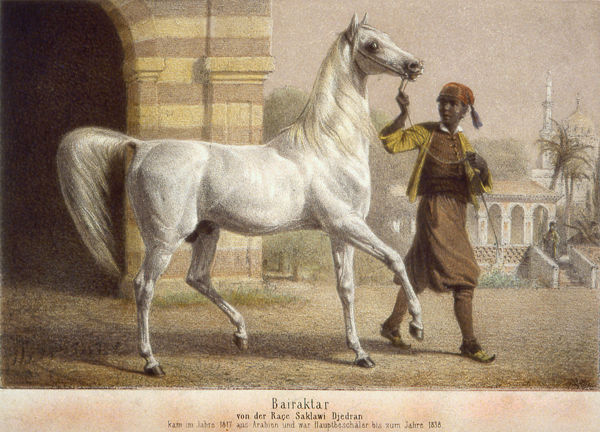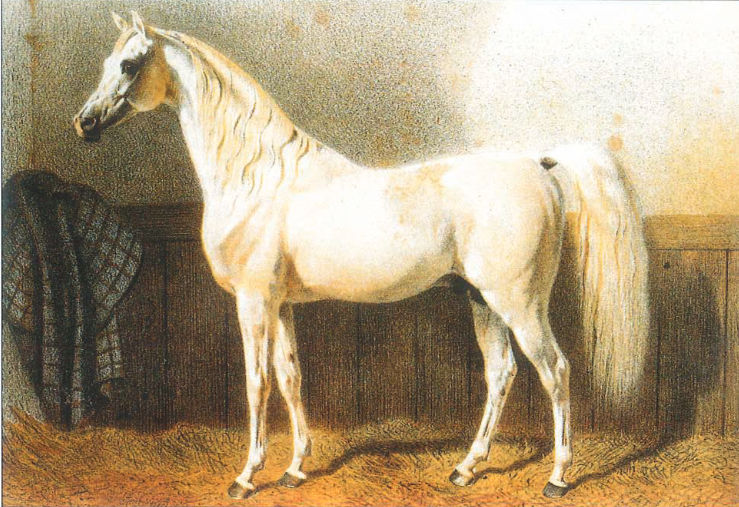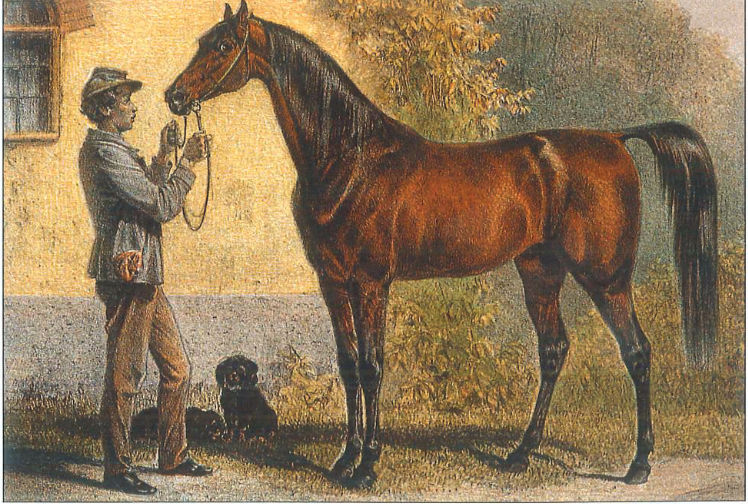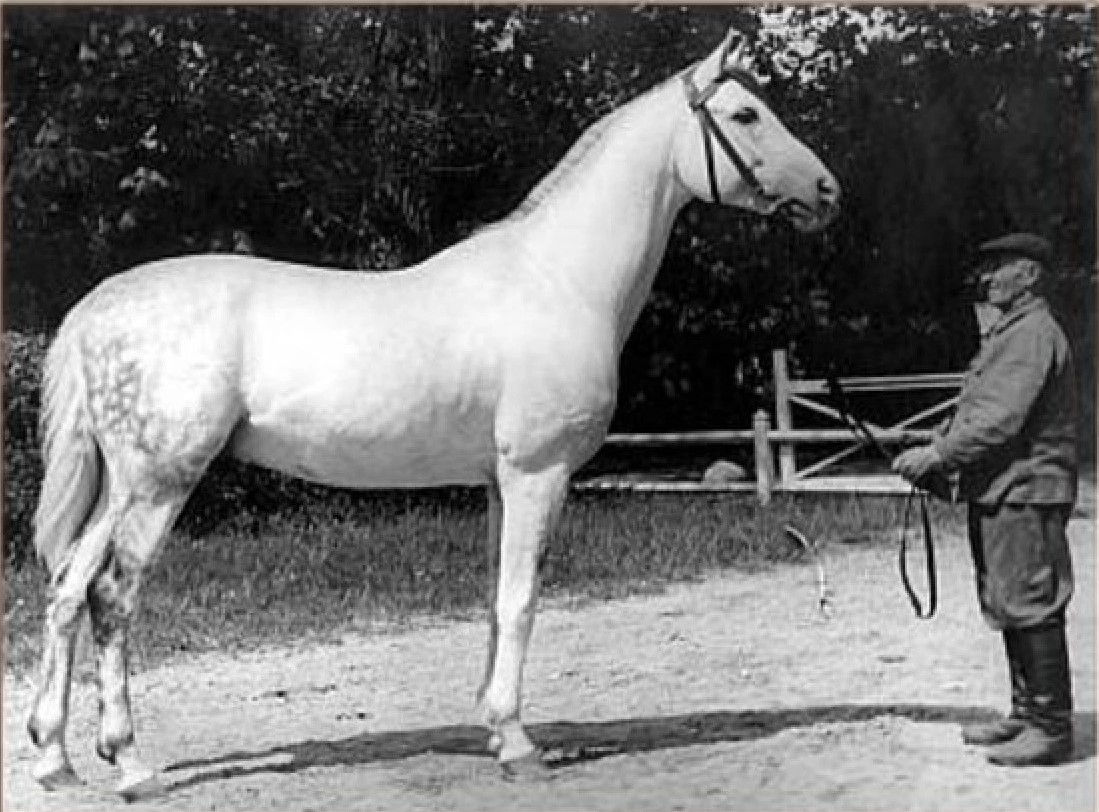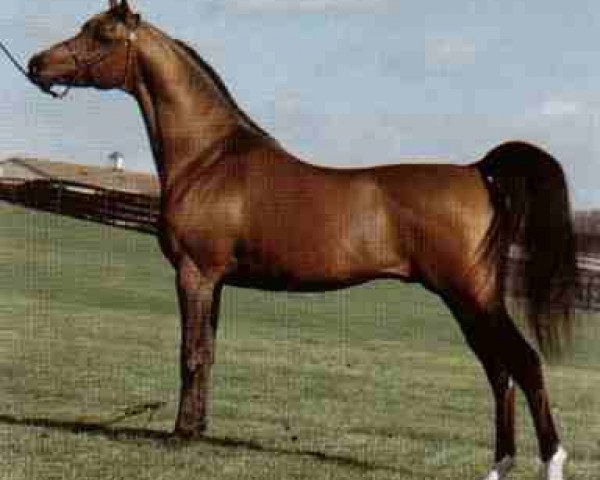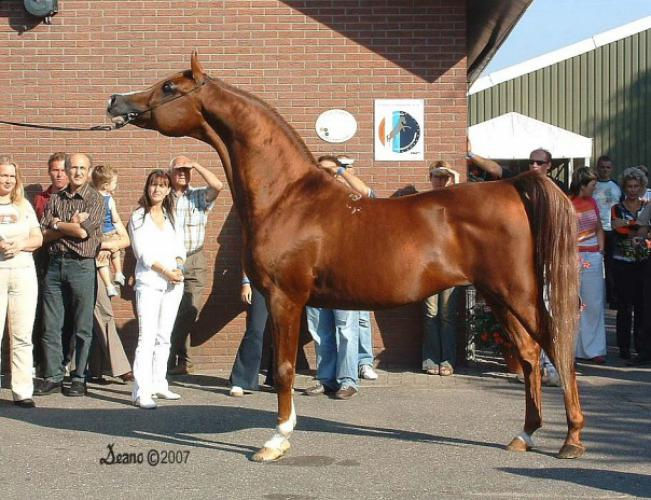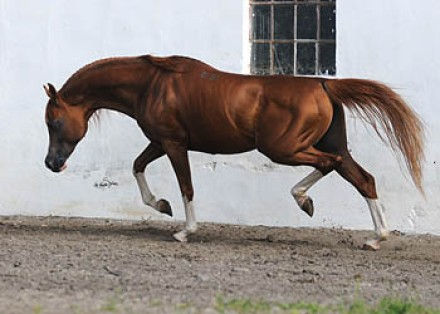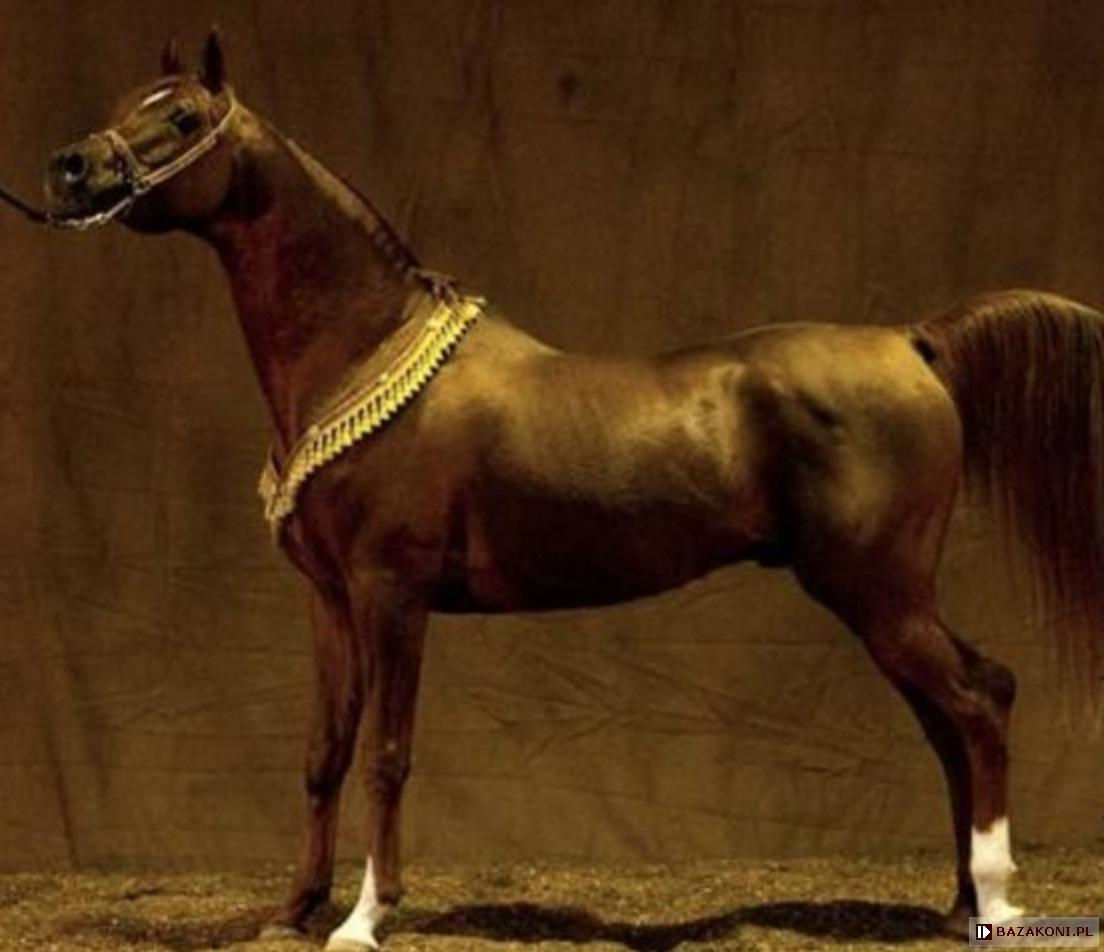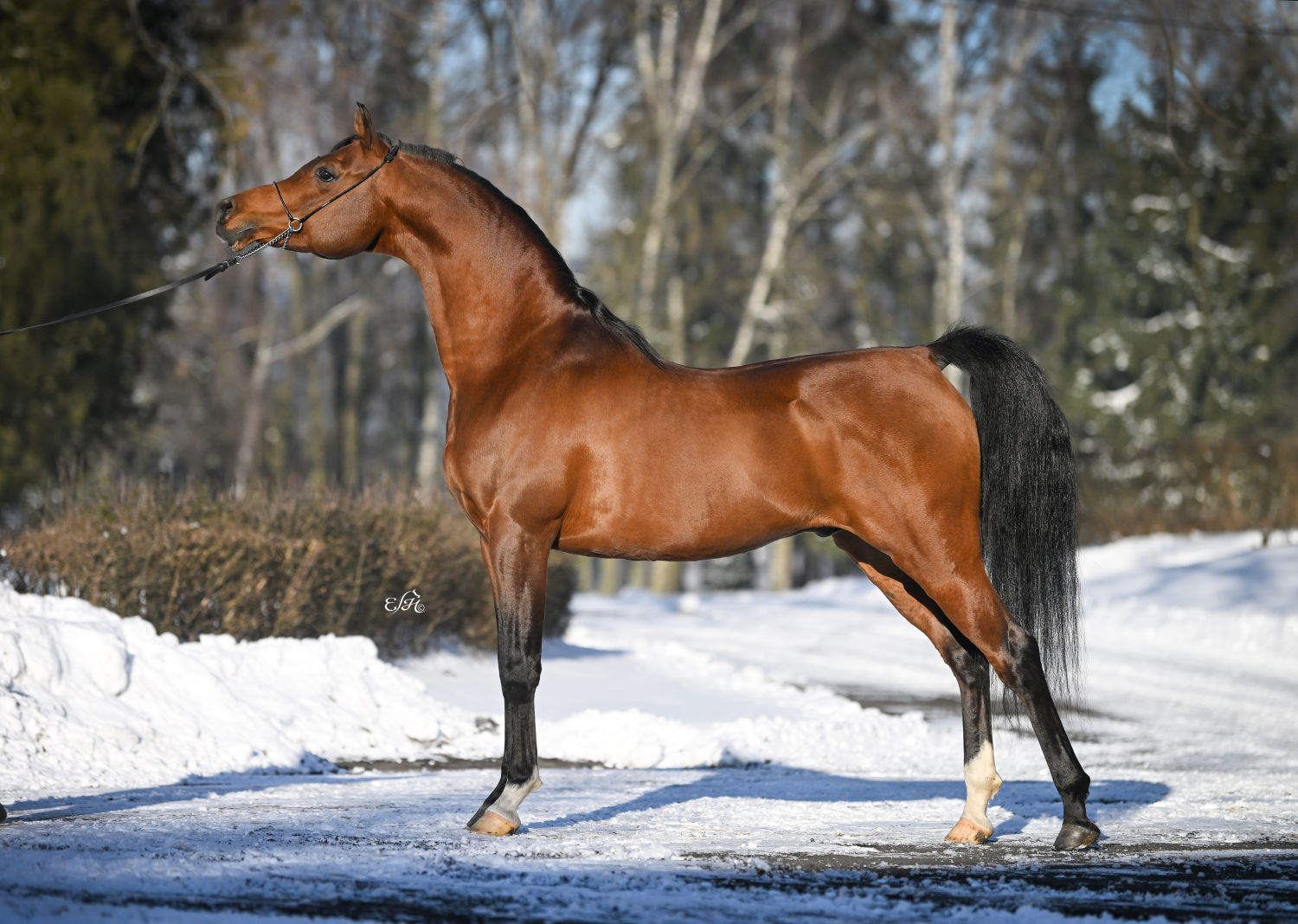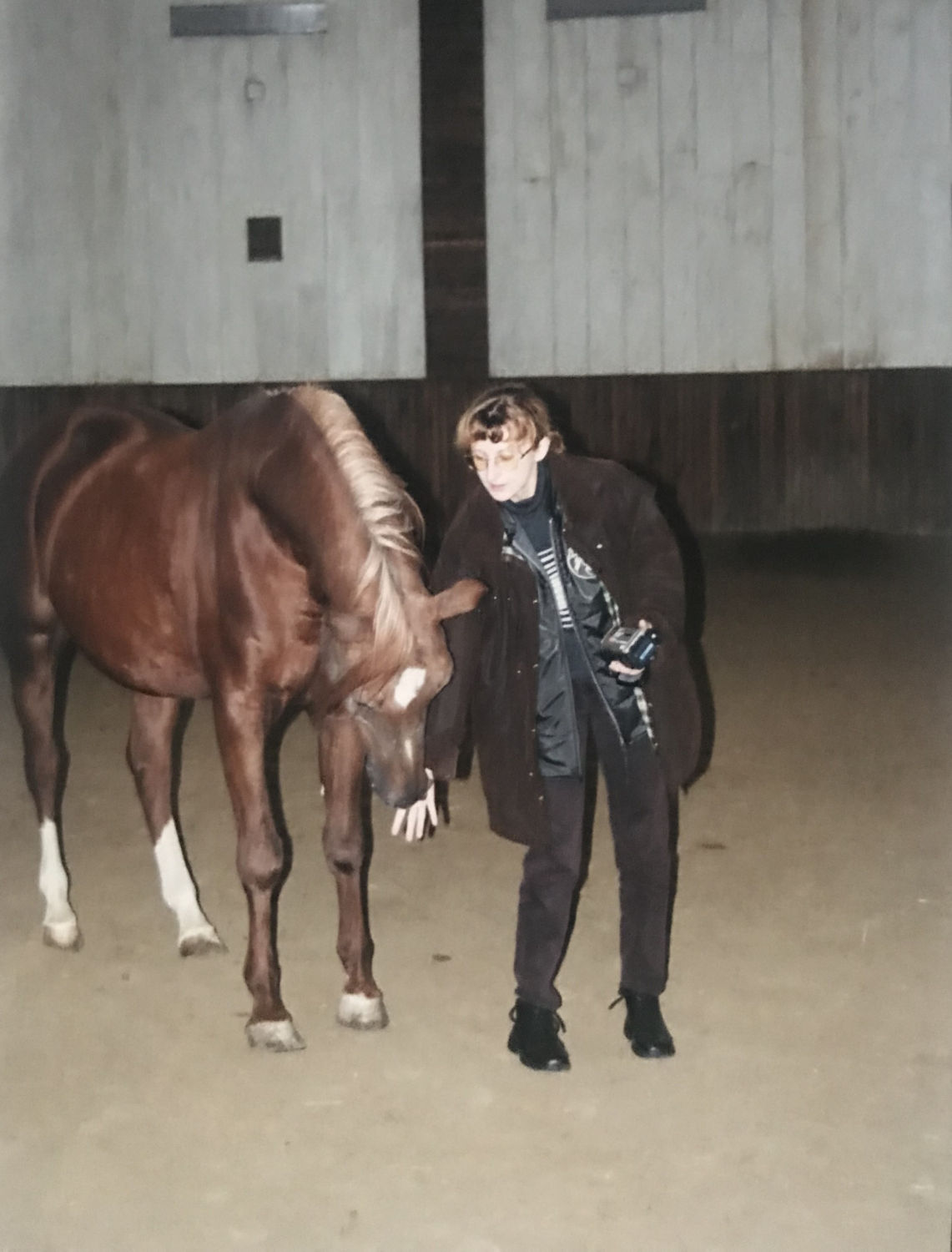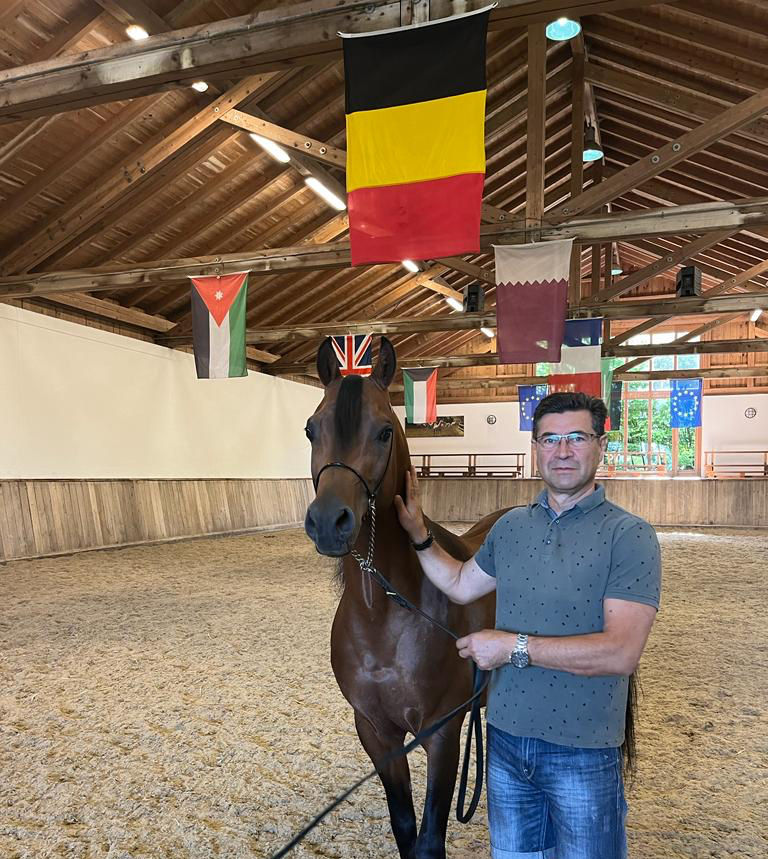ARTICLES
The sire line of Bairactar d.b. 1813 – forever alive
Bairactar or.ar. oleodruk von (Albrecht) Adam (zbiory prywatne)
źródło Wikimedia Commons
Author: Hanna Sztuka, Maciej Paweł
Grzechnik
The sire line of
Bairactar d.b. is the oldest, although not very numerously represented today, still active male line
in the breeding of pure-bred Arabian horses in the world.
It came to Europe
with the import of the original desert bred Arabian named Bairactar in 1817 to the royal stud farm
in Weil, who became the favorite horse of King William I. This relatively tall stallion (157 cm) was
characterized by extraordinary elegance and desert dryness. He was a beautiful horse, with a rather
straight profile of the head, but large eyes. These traits can still be seen in his modern
descendants. Even though he was intensively used in Weil for 21 years and left 7 sons, there was a
constant risk of his line becoming extinct. In contrast, he left as many as 37 valuable broodmares.
This tendency can still be seen in stallions of this line, who leave a large number of good mares
and only one or two sons capable of continuing the line.
Amurath I 1829 (Bairactar or.ar.-Sady III ) źródło Royal horses 2017, Marbach Stud
Bairactar died in
1839, so he lived to the age of 26, and his descendant Amurath of Weil lived to be 30. The feature
of longevity is characteristic of this line to this day.
Tadeusz
Piechocki:
“The stallion Bairactar was one of the best
stallions that have come from the desert to Europe so far. He was distinguished by extraordinary
refinement, correct build, strong base and excellent gaits, and possessed valuable reproductive and
hereditary strength.”
Tayar 1851 (Amurath-Geyran III) źródło Royal horses 2017, Marbach Stud
For the next 100 years, Bairactar blood
dominated the Arabian breeding at the stud farm in Weil, unfortunately already in the first
generation there was a tendency for only one stallion from each generation to continue the line. In
the first generation, it turned out to be Amurath I 1829, and then the son and grandson of Amurath
I, both named Tajar; Tajar 1851 and Tajar 1873, and further Amurath 1881, later called Amurath of
Weil (Tajar-Koheil III by Mehmed Ali). In 1895, the latter was purchased for the stud farm in
Radautz, from where his offspring spread all over Europe. Meanwhile, in Weil itself, the inbreeding
of Bairactar used for generations led to the breeding being oversaturated with his blood and
ultimately his line disappeared from the maternal stud. Amurath of Weil was described by Włodzimierz
Wnukowski as follows:
“(…) tall, very
refined and beautiful, with an impeccable build. Amurath produced in Radautz a whole line of horses
of this name with refined looks and beautiful lines, among which there was a large percentage of
correctly built individuals. The mares sired by Amurath, on average, were of better quality than the
stallions. Amurath was only accused of being somewhat soft in
use.”
After World War I, representatives of the Bairactar family
also reached Poland - the sons of Amurath from Weil: Amurath I 1903, Amurath II 1907 and Amurath III
1910, and a grandson - Nana Sahib I 1907.
Amurath I did not have an
influence on breeding, while Amurath III became the first purebred sire active in Janów Podlaski
after World War I.
Amurath III 1910
bay (Amurath 1881-O'Bajan by O'Bajan d.b.) born in Radautz, who, according to Witold
Pruski:
“He was a small horse, very dry, refined and
beautiful, very well built, with sliding, free movement. He stayed in Janów for a short time and was
used mainly for purebred Arabian mares and half-bred mares.”
Roman
Pankiewicz:
“It is a great pity that Amurath III, the
sire of such a mare as Bajka, was not used at a more serious stud breeding pure-bred Arabian
horses.”
Decisive in extending the Bairactar line were the breeding
activities of Amurath II and Nana Sahib.
Amurath 1881 (Tajar 1873-Kaheil III) z arch.R.Pankiewicza
Amurath II 1907 bay (Amurath 1881-Fatme d.b.) born in Radautz, was used in 1925 on a
small scale in Pełkinie, and during 1930-1931 in Breniów. In combination with Breniów's mare Sahiba,
Amurath II produced a stallion, Amurath Sahib 1931, who turned out to be the successor of the line.
Sahiba carried the blood of the stallion O'Bajan d.b., about whom Włodzimierz Wnukowski wrote
that:
“O'Bajan's offspring (...) were the best material
ever bred in Babolna. Therefore, O'Bajan was so appreciated that a monument was erected to him at
the maternal stud.”
Nana Sahib I
1907 grey (Selim - Smyrna d.b.) born in Weil. He was a refined stallion, with prominent
withers, good topline and sliding movement - he was used in Poland on a small scale, but left two
purebred mares who turned out to be valuable dams. In Breniów he gave the grey Sahiba 1924, out of
the mare Dońka imported in 1919 from Babolna. Sahiba was the first purebred Arabian horse to win the
Derby and Oaks in Poland. She produced valuable stallions such as Ibn Nedjari 1931 - a Derby winner,
and Sumak 1943, and the mare Siniora 1933, who unfortunately disappeared in 1944 with all her
offspring.
In Pełkinie, Nana Sahib I left the famous mare Zorza Pełkińska,
bay 1930 (out of Pomponia II by Mazepa I), who distinguished herself in breeding as the dam of the
stallion Geyran 1937 (sire of the mare Arwistawa 1958 - US and Canadian Champion
Mare).
Ultimately, Sahiba entered the history of world breeding thanks to
her son, the stallion Amurath Sahib, who turned out to be the successor of the Bairactar sire
line.
Amurath Sahib 1932 (Amurath III-Sahiba ) hod. Breniów , archiwum autora
Amurath Sahib grey, 1932
(Amurath II - Sahiba by Nana Sahib I) born in Breniów, represented a type of modern purebred Arabian
horse. Tall, in good frames, and very pretty. His long neck, beautiful head, correct posture and
horizontal croup still make a strong impression to this day. In the magazine "Hodowca Koni" [“Horse
Breeder”], published shortly after World War II, the famous pre-war hippologist and breeding
inspector Michał Jankowski wrote a description of Amurath Sahib, whom he had the opportunity to get
to know better during the ordeal with horses taken from Poland to Germany, in which he participated
with the Janów herd:
“The excellent
Amurath Sahib by Amurath II and out of Sahiba by Nana Sahib was also not lost. Due to his
correctness, height, bones and movement, this stallion plays and will play a very important role in
both purebred and half-bred breeding, both Arabic and
Anglo-Arabian."
Roman Pankiewicz about Amurath
Sahib:
“It was undoubtedly a very good horse. He
produced tall offspring with a wonderful topline ending with a perpendicular croup. He also passed
on correct structure, a long neck, and often, but not always, dryness. Unfortunately, his offspring
often did not equal the beauty of the offspring of stallions of Polish origin. After all, Amurath
Sahib was a product of Babolna and Radautz. These were very valuable stud farms, but the horses from
them were not equal to Polish ones in terms of type and beauty. His horses sometimes had a difficult
character, they walked well in harness, but they required a very sensitive
hand.”
Amurath Sahib began his stud career in 1937, when he was
purchased by the Stallion Depots and assigned to Bogusławice. Widely used in breeding in Kraśnica,
Wodzisław and Klemensów, he distinguished himself as the father of several stallions and
particularly valuable mares. Already in the first years he produced such valuable daughters as: Lala
1938 and Amneris 1940, born in Wodzisław, and Bałałajka 1941 in Kraśnica. In 1943, Amurath Sahib was
assigned to Hauptgestud Janów Podlaski, and in the spring of 1945 he reached Germany, where,
together with a herd of Janów stallions, he survived the bombing of Dresden. He was one of the main
stallions used at Nettelau during 1945-1946. Recovered for Poland in 1946, he was sent to Posadowo.
Under the influence of Dr. Edward Skorkowski's views, in post-war Poland, horses that ultimately
survived the war were divided into herds of the Kuhailan type (Nowy Dwór and Albigowa) and Saklavi
herds (Klemensów/Michalów). Amurath Sahib went to Klemensów, where his sons were born, of whom Arax
1952, after being sold to Tersk, turned out to be the successor of the sire
line.
Arax 1952 (Amurath Sahib-Angara) hod.Klemensów, arch.autora
The used in Klemensów Amurath Sahib had a huge impact on the herd
assigned to him – which was transferred to Michałów in 1953. The then manager of this stud farm,
Ignacy Jaworowski, characterized Amurath Sahib and his role in establishing the Michałów stud farm
as follows:
“Grey, dry with a great
expression, medium-sized head, very long neck, long perfect topline, especially a great horizontal
croup, which he was able to pass onto his offspring. Correct limbs and good movement characterized
this horse. The stallion made an impression with his type, masculine expression and good head,
although he was a bit flat. His foals have large frames, but not all of them are beautiful,
sometimes with long loins and not always dry... Mares by Amurath Sahib are outstanding broodmares to
whom Polish breeding owes its global fame and outstanding
achievements.”
Amurath Sahib produced a total of 15 mares (3 of them
became dams of stallions in Poland), and 5 stallions, of which in Poland were used: Equifor, Arax
and Gwarny, the remaining two as well as Arax were sold abroad. He produced many brave horses: Adis
Abeba won the Oaks in 1947, Estokada won the Oaks in 1951 and the Criterium Stakes, Equifor 1951 -
the Derby. Amurath Sahib's three sons were also used in half-breeding. Roman Pankiewicz
characterized the offspring of Amurath Sahib as follows:
“His daughters mated perfectly with very different stallions, producing
many excellent horses, including championship winners: Bałałajka 1941 produced Bask, champion of the
USA and Canada; Amneris 1940 – Aramis 1961, champion of the USA and Canada; Darda 1950 – Dornaba
1960, champion of the USA and Canada; Gwadiana 1952 – Gwalior 1961 – Canadian champion and
three-time reserve champion of the USA; Estokada 1951 – Estebna 1969, European Champion, and these
are just the most important ones.”
Amurath Sahib was the only one
from his line to survive World War II and currently all the horses of the Bairactar d.b. line. are
his descendants. He was the last stallion from the Bairactar d.b. line to be recognized as "asil" by
the Asil Club. Most of the horses recognized by the Asil Club were Straight Egyptians, and the
Babolna group carrying Amurath Sahib blood was an exceptional source of blood for the breeders in
the Asil Club. As later history showed, another stallion who extended the lineage: El Nabila B, also
came from Babolna, and his mother had a pedigree heavily steeped in Egyptian
blood.
The sire line of Amurath Sahib / Arax in world breeding
The Russians, appreciating the quality of the breeding material
stolen from Poland in 1939, eagerly reached for Polish Arabians even after the war. They purchased
in Poland the stallion Arax, bay 1952 (Amurath Sahib out of Angara by Wielki Szlem), a transaction
which turned out to be very beneficial for the further breeding of Arabian horses in the world. It
is worth emphasizing here that Arax's dam, Angara 1947, was the daughter of the mare Brda 1934, from
the Babolnian family of Semrie d.b. purchased in 1945 by the Polish Stud Board in Germany for Polish
state stud farms. In the following years, Arax became the pillar of Tersk breeding, producing
several dozen descendants, including the extremely important stallions: Nabeg and
Tamerlan.
Nabeg 1966 (Arax-Nomenklatura) hod.Tiersk, arch.autora
Nabeg 1966 bay (Arax out
of Nomenklatura by Naseem) bred by Tersk. Nomenklatura was the daughter of the famous Mammona (by
Ofir), born in 1939 in Janów (robbed by the Russians and kidnapped along with other horses to Tersk
in the Caucasus). Nabeg was used for breeding in Tersk from 1971 until his death in 1978. Soviet
hippologist Oleg Bakszyszyn described Nabeg as follows:
“A typical kuhailan, small but very massive. Correct build. He raced for
two seasons in Pyatigorsk (in Russia, Arabians raced as two- and three-year-olds, author's note),
taking part in nine races 9 (2-1-3-1).”
His description from the
breeding plan of the stud farm in Tersk is quoted by Roman Pankiewicz:
“Kuhailan, measurements at the age of 5: 150-184-19, very massive and
bony, wide head, high neck, correct top line, dry, properly positioned limbs. Like his father, Arax
was distinguished by health, a strong constitution and excellent
movement.”
Nabeg extended the line by giving a number of excellent
sons used in breeding: Nariadni 1973, Mustang 1974, Pesniar 1975, Menes 1977, Peleng 1978 and Tallin
1978. The stallion Tallin 1978 was used in Polish breeding, but ultimately this line was extended
for world breeding by another son of Nabeg born in Tersk, the stallion Menes
1977.
Menes 1977 (Nabeg-Metropolia) hod.Tiersk, źródło Wikimedia Commons
Menes 1977 bay (Nabeg out of
Metropolia by Priboj) bred by Tersk. He was a very harmoniously built horse with measurements of
153-181-18.5. He also had a solid racing career of 13(6-0-4-2). He was bred at Tersk, exported to
the USA, and spent the last 12 years of his life in the Netherlands, where he produced many
excellent horses.
Menes was used scarcely in Poland, where he produced the
chestnut stallion Gaskończyk 1993 (Menes – Gaskonia by Probat) bred by Michałów
Stud.
Krystyna Chmiel: “Breeding Gaskonia
- the distinguished dam of top stallions Grafik 1996 and Gaspar 1998 - to Menes, a Tersk-bred
grandson of the Polish stallion Arax, inbred to Mammona, was probably a form of experiment. Although
Gaskończyk completed the full racing trials on the Polish track, (...) he left no offspring in
Polish breeding.”
Despite long years spent away from his home stud,
it was in Tersk that Menes produced his most important son, the stallion Balaton 1982 chestnut
(Menes out of Panagia by Aswan(EG)). Balaton is one of the most significant stallions in today's
breeding of purebred Arabian horses. Through his daughters and sons, the most outstanding of whom
was Kubinec 1987, he influenced breeding and at the same time extended the Bairactar d.b. lineage
descending from Arax 1952. Although he was leased to the Netherlands and spent three years in
Kossack Stud, he left his best offspring in Tersk. During his stay in the Netherlands, he became the
champion of this country twice and, among others, the European Champion. In the Bairactar line ,
where since the times of Amurath Sahib there was a problem of obtaining a class continuator of the
family - such a horse in Balaton's offspring turned out to be the stallion Kubinec
1987.
Balaton 1982 (Menes-Panagia) hod.Tiersk, źródło Wikimedia Commons
Balaton was also considered a chef sire by Polish breeders. However,
director I. Jaworowski and the chief head J. Budny, when choosing a stallion from Arax's
descendants, rejected Menes' son, Balaton 1982, and paid attention to his grandson (through Nabeg),
the stallion Tallin. Ignacy Jaworowski justified this choice as follows: “The introduction of proven, beautiful Egyptian blood seemed to be purposeful. Regardless
of Amurath Sahib 1932, Tallin introduced the valuable blood of Skowronek 1909. He was a better and
more attractive horse than the strongly deformed, chestnut Balaton we were
offered.”
In hindsight, however, it is difficult to agree with the
opinion that Tallin was a horse better suited to the Michałów herd than Balaton. Ultimately, Balaton
turned out to be able to continue the family in the modern type of saklavi, and Tallin,
unfortunately, was unable to do so. Tallin sired the very good Wojsław in Michałów, and he even had
several sons, including Druid, Emanor, Monar and Werbum in Michałów, and Sabat and Pentagram in
Janów, but in the next generation the line was poorly continued. Druid, a great performer, was sold
to Turkey early on, but left behind in Polish breeding the handsome, although different from the
then new fashion, stallion Pentagram, who had been forgotten for many years at Białka Stallion Depot
before being sold into private hands. After many years, Pentagram was leased to Białka at the age of
22, producing several promising male descendants there. Emanor was sold to the USA because he was
too athletic for the Polish standards of the time, with a heavy head and not very subtle in type.
Monar, left in Michałów as Wojsław's successor, did not leave any valuable offspring, and after
losing fertility, he was used as a tester. Werbum was withdrawn from breeding early due to body
defects, but turned out to be the most valuable of them, producing several valuable and beautiful
daughters, including the mare Mata Hari, dam of the stallion Medalion. For this reason, male blood
derived from Tallin in Polish breeding today is of a utilitarian nature, and stallions derived from
Balaton are valued for their versatility and the widely sought-after Arabian
beauty.
Hanna Sztuka: “I had the
opportunity to see the already aged Balaton in Tersk and I must say that the above-mentioned
postural defects of the front legs were indeed visible in the stallion, but they did not occur in
his beautiful daughters. It's a pity that this stallion wasn't able to meet the mares in
Michałów.”
Balaton was an extremely popular stallion in the 1980s,
and his offspring sold from Tersk spread all over the world. They were so valued that in Tersk some
mares were bred to Balaton for several consecutive years, producing offspring that easily found
buyers. Kubinec’s 1987 dam, Kosmetika 1976, was bred to Balaton four times in the years
1985-1988.
Hanna Sztuka: “Even as an elderly senior, Balaton retained his
masculine charisma, outstanding movement and excellent condition. When such an opportunity arose, I
purchased a daughter of the stallion Balaton, the mare Missia 1998, for Tarus Arabians, which turned
out to be an excellent acquisition, being at the same time a representative of the Sahara d.b. line
/ Mammona reintroduced to Polish breeding in this way.”
Kubinec 1987 (Balaton-Kosmetika) hod. Tiersk, źródło Wikimedia Commons.jpg
Kubinec 1987 chestnut (Balaton out of Kosmetika (SU) by Muscat
(SU) bred by Tersk (SU). Although Balaton was used in Tersk for many years, the successor of the
family was born already in the second year of his breeding career. His dam Kosmetika 1976 is
probably the key to the breeding success of this stallion. Kosmetika came from the dam line of
Sahara d.b. and descended in a direct line from the Janów mare Limba 1930 (stolen from Janów by the
Soviets in 1939). Kosmetika's dam, Karta by Arax, was also a daughter of the stallion Muscat from
the Skowronek line. Muscat is one of the most famous sires that have made a name for themselves in
world breeding through sales to the USA. Kubinec was exported to the Netherlands and then sold to
Germany. His show career was very successful, including the titles of European and World Champion
and All Nations Cup Reserve Champion. In the show ring, he attracted attention with his statuesque
figure and dynamic movement. Kubinec became an important stallion that influenced modern breeding,
mainly due to the mares used in breeding and the sons who extended the
lineage.
In Germany, Kubinec produced the stallion Koronec 1993, popular in
the show rings, and exported to Saudi Arabia.
Koronec 1993 grey (Kubinec out of Precious Me by Wildwood Kochar), bred by Almut von
Anshelm. The son of a Russian World Champion and a Canadian mare, he is a modern example of an
Arabian horse crossing political boundaries. His pedigree is a mixture of the best Russian (i.e.
mainly Polish) and American families. With his long, arched neck, well-balanced body, extremely flat
topline, elegant movement and commanding presence, Koronec made a colossal impression. Before being
exported to the Kingdom of Saudi Arabia, he won many distinctions in Europe, including the titles of
European Champion and All Nations Cup and World Junior Reserve Champion in
Paris.
Hanna Sztuka: “Extremely
masculine, correct, athletic with a beautiful head and outstanding movement. His topline was the
ideal of the Polish image of this feature. Koronec made a huge impression and I never had any doubts
that he was the stallion I was looking for my herd. Unfortunately, he was sold to Saudi Arabia and
breedings were not available. It is difficult to say how well he was used there, as few of his
offspring could be seen at shows.”
The only known male offspring of
Koronec so far is the born at his owner's stud farm bay stallion Sabea Al Sahraa 2002 grey (Koronec
(DE) – Nouf Al Thalitha by Thee Desperado), used in breeding at Athbah Stud in
2006-2023.
Another son left by Kubinec in breeding is FS Bengali 1994 grey
(out of Om El Sanadiva by Sanadik El Shaklan bred by F. Spunle). In the junior category he won the
titles of German Champion, All Nations Cup Reserve Champion in Aachen, World Reserve Champion and as
a senior again the title of German Champion, and then continued his show career in the USA, winning
the 2002 Champion Stallion title in Scottsdale, and in 2003 the title of US National Champion, thus
becoming the first German-bred horse to win this title. The impressive show career of this stallion,
unfortunately, did not translate into comparable success in breeding, although he left the stallions
Maran 2009 and Eternal 2008 in Poland, used in breeding.
Maran 2009 bay (FS Bengali od Missouri by Wachlarz) bred by
Tarnawka Stud, who had 10 offspring in private breeding.
Eternal 2008 chestnut (FS Bengali od Ewitacja po Ganges) bred by
J.Głowacki. Krystyna Chmiel: “His dam, the chestnut mare Ewitacja,
stood out because she was probably the only daughter of Ganges with a slim head profile. Eternal
himself was characterized primarily by an "ironing board" topline and impressive, showy movement.
This resulted in the Polish Junior Reserve Champion Stallion title in 2009, but he not only had
these qualities, but also passed them on! Up to 2018, Eternal sired only 12 offspring, when in the
2018 season he was given the opportunity to test himself on mares in Michałów. Apart from a few
interesting mares, he left no successor there.”
Another excellent
son of Kubinec and the continuator of the line was the stallion El Nabila B, bred by the Hungarian
stud farm in Babolna, and then his sons.
El-Nabila-B 1996 (Kubinec-Elf Layla Walayla) hod.Babolna , źródło Wikimedia Commons
El Nabila B grey, 1996 out of 218 Elf Layla Walayla B by Assad, is so far the last
significant horse coming from the famous breeding farm in Babolna. His dam Elf Layla Walayla B,
World Reserve Champion in 1998, was the quintessence of the Babolnian type, which in the mid-1990s
was lost along with the entire Babolnian breeding. El Nabila B was briefly used in his birthplace
and then sold to Brazil, where in 2001-2006 he produced numerous offspring. Since 2006, the stallion
has been owned by the famous American stud farm Om El Arab and is used in world breeding with great
success.
In the years 2006-2009, frozen semen of El Nabila B was imported
to Poland and used in Janów and Michałów, from which several mares and one stallion were born. Mares
by El Nabila B did not play any significant role in Polish breeding, and his son Almanzor, born in
Janów, used rather sparingly, produced one good daughter and a son in Janów, which, however, was
ultimately retired from stud. At the peak of El Nabil B's popularity in the USA, he was bred to two
Polish mares on lease there. And so the following were born: H Emandilah H, bay 2008 (El Nabila B
out of Emandoria by Gazal Al Shaqab) and AJ Penelope grey 2008 (El Nabila B out of Pianissima by
Gazal Al Shaqab), both bred by Pride of Poland USA, LLC. AJ Penelope was purchased years later by a
Polish breeder and is currently a broodmare at Klikowa Stud.
Almanzor, grey 2009 (El Nabila B out of Alantina by
Emigrant).
Krystyna Chmiel is surprised that “he was used at the parent
stud on such a limited scale, only in the 2018 and 2019 seasons. He produced 2 colts and 3 fillies,
mostly sold as two-year-olds.”
In the USA, El Nabila B had the sons Titan
and Atticus.
Titan AS, chestnut
2012 (El Nabila B (HU) out of Om El Beladeena by Al Lahab). This stallion extends the branch of the
family, giving successors in the form of the stallions Midas AS 2016 (US) and CA Amadeus 2019
(KSA).
Atticus ENB, grey 2015 (El
Nabila B out of Om El Benedine by Sanadik El Shaklan) - bred in the USA, the son of the excellent
mare Om El Benedine from the Om El Arab stud, after considerable success and extremely intense
promotion around the world, was used at the Stud Farm in Michałów, where the first offspring was
born in 2023.
The only breeding episode in Poland of Kubinec, so popular
due to his achievements, was his use at Tarus Arabians, where the stallion Setnik 2001 chestnut (Kubinec – Sieć by Europejczyk) was born. This Saklawi-type
stallion, used on a small scale - correctly built and in large frames, was also used in half-bred
breeding (assessment points: 82 points). His half-breed offspring turned out to work very well under
saddle and were characterized by good rideability.
Setnik 2001 (Kubinec-Sieć) hod.Tarus Arabians fot.S.Iłenda (2010)
Another vital branch of
the Arax family turned out to be the one founded by Kubinec at the Bavarian stud farm Sax
Arabians.
Kubinec's son, the stallion Meshan Ibn Kubinec 2003, chestnut, out of Menasch by Menes, was born there. In turn he
produced the stallion Marshan.
Meshan_Ibn_Kubinec 2003 (Kubinec-Menascha) hod.Sax Arabians, źródło arch.Sax Arabians
Marshan
bay 2008 out of Marni by Windsprees Mirage by Thee Desperado, impressive with great movement
with a suspension phase in the trot and such a distinctive Arabian bouquet, which is rarely seen
today, is the winner of several European shows: Kreuth, Deauville, Travagliato and German National
Champion. Marshan, breeding at his maternal stud Sax Arabians, produced the stallion
Elshaan.
Marshan 2008 (Meshan Ibn Kubinec-Marni) hod. Sax Arabians, arch.Sax Arabians
Elshaan bay 2015 out of Elena Bint Europe by Europe Al Khidar,
despite his pedigree devoid of recently fashionable Middle Eastern stallions, is the winner of
several European shows (Prague, Berlin) and, like his father, German National Champion. In Elshan's
pedigree, almost 60% of the blood comes from Tersk, leading straight to horses bred in Poland. For
this reason, despite the significant distance of subsequent generations not only from Russian
breeding, but even more so from Polish breeding, he meets the requirements for belonging to Pure
Polish. In the male line, Elshaan is a descendant of the stallion Bairactar d.b., recognized by the
Polish breeding program, and in the female line, his pedigree, through Mammona 1939 from Janów,
leads to the founder of the family, the mare Sahara d.b. imp. 1845 to
Jarczowce.
Elshaan 2015 (Marshan-Elena Bint Europe) hod.Sax Arabians fot.E.Imielska-Hebda arch. SK Białka
Elshaan's pedigree is filled with the blood of Polish
progenitors. Kubinec himself, in his pedigree, carries the triple blood of Mammona and the stallion
Negatiw, who, being a descendant of Skowronek through Naseem, is also a son of the Polish Taraszcza
(looted in 1939 by the Soviets from Janów). Kubinec, whose pedigree often includes 25% Crabbet
blood, is filled with over 50% Pure Polish blood. Therefore, Elshaan, being a direct descendant of
Amurath Sahib (Arax's sire), has Menes (Arax's grandson) four times in his lineage, in whom we also
find Piołun and Mammona. This mare appears in Elshaan’s pedigree many times through the mare: Neshi,
4 times, including 3 times through her daughter Nascha, and 1 time through the mare
Nenija.
Hanna Sztuka z ogierem Balaton, Tiersk 10.2000r. arch.autora
Elshaan also has among his ancestors the stallion Vympel, inbred
three times to Mammona, a great-grandson of Arax. The well-known stallion Khidar, on the maternal
side, also represents the Sahara family, but through Pomponia. On the maternal side, in Elshaan's
pedigree we find the triple-crowned World Champion mare Esteema 1998, chestnut, who on her dam’s
side is inbred to Nabeg by Arax, but also Mammona. Esteema is the daughter of the American,
triple-crowned stallion Essteem 1991, a grandson of the legendary Bay Shah 1976, whose pedigree
includes Albigowa's Bask 1956.
Maciej Grzechnik describes Elshaan this
way:
„A stallion with an extremely interesting and
valuable origin from the point of view of returning to Polish genetics. He should be considered a
complete stallion due to the pedigree supported by excellent physical characteristics. Elshaan is a
refined, but also real stallion with clearly marked features of an Arabian horse, characterized by a
gentle and friendly character. He is a properly built stallion, with a perfectly set and lofty
swan-shaped neck. His classic, slim-profile Arabian head with a dark and large eye should be
considered an exemplary type of beautiful head, free of facial deformations that reduce the utility
value of such a horse. Good topline, with a long and straight croup, ending with a high-set tail.
The body is based on a solid foundation - strong hooves and properly built limbs - the quality of
which is particularly visible in the impressive movement, which is rarely seen today: an extremely
active front and a strongly pushing rump.”
Maciej Grzechnik z ogierem Elshaan, Sax Arabians 2023, arch.autora
The pedigree full of
Polish ancestors and the excellent phenotype along with the character traits of Elshaan, brought to
Białka Stud in the 2024 season, are a valuable acquisition for the Polish breeding of Arabian
horses. We can only hope that his genotype, inbred to valuable horses, and confronted in particular
with mares of classic Polish pedigree, will give his descendants the best of him: the charisma and
harmony of a wonderfully built Arabian stallion, carried around the arena with spectacular and
perfect movement in all three gaits.
The Bairactar d.b. sire line being the
oldest active male line in the breeding of pure-bred Arabian horses in the world, although it was
founded by the original Arabian - a stallion called Bairactar brought from the desert - in the
German stud farm in Weil, its history is truly international. Its representatives from Germany go to
breeding farms in Austria-Hungary, Poland, Soviet Russia, Hungary, the United States and again to
Germany, so that thanks to Elshaan they will once again have a chance in Polish breeding. It is to
be hoped that the line will take advantage of this opportunity and become a worthy successor, and
the Bairactar family will continue to be "forever alive".




